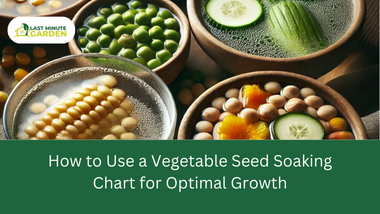Want to improve seed germination and grow healthier seedlings? A vegetable seed soaking chart might be the answer. This tool can change your gardening game, producing a rich harvest of fresh produce.
As gardeners, we can assist our seeds by mimicking what happens in nature. This improves germination speed and rates, resulting in healthy seedlings.
Whether to soak or not to soak is a personal preference. Here, I’ll discuss why soaking may help seed before planting, its purpose and benefits, how to prepare seed for soaking, and simple methods.
Vegetable Seed Soaking Chat: Why Soak Seeds Before Planting
Seeds comprise an embryo inside an outer, protective covering. In simple terms, germination occurs when the embryo ‘shoot’ breaks through the outer covering.
To do this, the seed needs a source of constant moisture, and light or darkness depending on what it is. For example, lettuce germinates in light but tomato seed needs to be covered with soil which provides darkness. The water softens and breaks the seed coat. The thicker the seed casing the slower the seed germinates.
The water is usually in the soil where the seed falls, and when enough has been absorbed by the seed coat, germination begins. However, particularly in very sandy soils where the water drains away quickly, soaking the seeds before planting will help initiate germination.
Purpose of a Vegetable Seed Soaking Chart
A soaking chart provides clear guidelines for how long to soak each type of seed, making the planting process more efficient.
The chart provides specific soaking times for different vegetable seeds, helping to ensure that they absorb enough moisture to initiate the germination process more quickly.
The vegetable seed soaking chart can help gardeners understand the differences in soaking needs among various vegetable seeds, aiding in the selection of appropriate seeds for their garden.
Seeds require moisture to initiate germination. The chart ensures that the seeds have the right amount of water to start the metabolic process.
For novice gardeners, a vegetable seed soaking chart can serve as a practical educational resource, helping them learn about seed germination and care.
Components of a Typical Seed Soaking Chart
A detailed seed-soaking chart includes:
- Seed Type: Include seeds such as beans, peas, corn, herbs, or plant species in the chart.
- Soak Duration: The chart should provide the recommended amount of time to soak the seeds.
- Water Temperature: The right temperature should be provided. For example, warmer water speeds up soaking, while cooler water slows it down.
- Seed Quantity: Include the number of seeds per volume of water or guide spacing for better results.
- Soaking Notes: Indicate whether seeds need to be rinsed, checked for viability, or need scarification before soaking.
- Post-Soak Instructions: Provide instructions on what to do after soaking whether planting immediately or transferring to a damp paper towel for further germination.
- Soil or Germination Tips: Any special advice regarding the soil type, planting depth, or temperature conditions that help the soaked seeds sprout successfully should be included.
Preparing Seeds for Soaking
Before you can use a vegetable seed soaking chart, you need to prepare your seeds.
Start by sorting and cleaning your seeds. This step helps you find the best seeds and get rid of any bad ones.
Seed Sorting: Sort through your seeds to find the plump, healthy ones. Leave out any shriveled or damaged seeds.
Seed Cleaning: Use a fine-mesh sieve to remove dirt and debris from your seeds. This makes them ready to soak up water.
Seed Organization: Organize your seeds by type, size, or maturity. This makes it easier to follow your soaking chart.
| Step | Description | Benefits |
| Seed Sorting | Separating viable, healthy-looking seeds from any damaged or shriveled ones | Identifies the most viable seeds for soaking and germination |
| Seed Cleaning | Removing chaff, dirt, and other debris from the seeds using a fine-mesh sieve or screen | Ensures a clean surface for optimal water absorption during soaking |
| Seed Organization | Grouping seeds by variety, size, or maturity | Makes it easier to reference the seed soaking chart and apply the appropriate soaking time for each type of seed |
How to Use a Vegetable Seed Soaking Chart
Identify which vegetable seeds you want to plant by referring to your garden plan. Once you have your list, check the soaking chart for the recommended soaking times for each vegetable seed.
Use any regular bowl or jar and fill it with filtered warm water. If the water is too hot for you to leave a finger in, it’s too hot for your seeds. Refer to the soaking chart to know the right temperature and amount of water to use.
Place the seeds in water and let the pre-soaking process continue. Use the chart to soak the seeds for the recommended duration. Set a timer to ensure you don’t soak them for too long.
Immediately after the seed soaking period is over, the seeds need to be planted out. They cannot dry out again as that would keep them from germinating at all.
Be sure to know where the seeds are going and to have either your garden prepped or seed trays ready to go when you start soaking seeds.
After soaking the seeds and transplanting them, refer to your germination chart to keep the soil moist continuously for the first few weeks of growth. This pre-soaking will hasten germination by a few days and up to a week.
The Best Seeds to Soak

The chart gives soaking times based on seed size, hardness, and dormancy.
| Vegetable Seed | Soaking time(hours) |
| Corn | 8-12 |
| Cucumbers | 6-8 |
| Pumpkin | 8-12 |
| Peas | 6-8 |
| Beans | 8-12 |
| Okra | 12-24 |
| Beets | 2-4 |
| Peppers | 8-12 |
| Tomatoes | 6-8 |
| Eggplant | 8-12 |
Summary
Soaking vegetable seeds before planting can improve germination rates and lead to healthier plant growth.
Knowing the specific soaking times and water temperatures for each seed type can help gardeners optimize their planting process.
Proper post-soaking care ensures the seeds are ready for successful growth, giving you a head start on a productive growing season.
Take the next step towards a thriving garden! Soak your seeds and watch your vegetables flourish.





